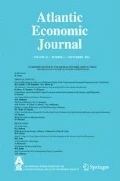Abstract
Speculative capital inflows raised the exchange rate and stock prices in Iceland in the prelude to the financial turmoil that gripped the country in 2008. Speculators profited from the interest differential as well as the continued appreciation of the currency from 2004 to 2008 and the rise of stock prices. The inflow was not sustainable because domestic debt was increasing at an unsustainable pace, faster than the rate of interest. Investors attempted to leave the krona when international capital markets became unstable in 2008 and the foreign risk premium rose. The sudden stop of the inflows left most domestic businesses in technical default as well as many households, the banks collapsed and the currency lost half its value. Capital controls were imposed to stem the outflow. Now seven years later, capital controls are being relaxed and the inflow of speculative capital has started again. The paper describes the macroprudential regulations that have been passed in recent years and the possible ways the authorities could reduce the inflows or change their nature from short-term to long-term investment. The issue whether a very small economy can have a floating exchange rate and a free flow of capital is discussed.




Similar content being viewed by others
Notes
The EEA was created by the European Union at the beginning of the 1990s in order to allow Finland and Austria access to the European single market without full membership of the European Union, which was thought to be impossible due to the perceived interests of the Soviet Union. However, the collapse of the Soviet Union in 1991 made it possible for these two countries to become full members. Instead, Norway, Iceland and Liechtenstein became members of the EEA without EU membership, the primary reason in the case of Iceland and Norway being a concern about retaining full control of these countries’ fishing grounds.
See Calvo (1998) on sudden stops of capital flows.
What followed were daily auctions of euros that created a market price for the euro, which was then used to price other currencies using the exchange rates in world markets.
See, amongst others, Thomas (2006). “Icelandic Banks: Not What You Are Thinking.” Merrill Lynch High Grade, 7 March, 2006.
Table taken from Benediktsdottir et al. (2011).
Source: Directory of Traffic (Umferðarstofa, http://www.samgongustofa.is/).
A depreciation did occur in February 2006 but was followed by an appreciation later in the year.
See Portes and of the krona Baldursson on this point (Portes and Baldursson 2007).
Defined as anyone who has a legal residence in other countries, independent of nationality.
Defined as investment in debt securities and equity securities, foreign direct investment excluded.
Other countries have used this system in the past, for example Chile between 1991 and 1998, Colombia in 1993–98, Thailand in 1995–96 and 2006–08 and Indonesia and Peru since 2010.
This system was used in Brazil in 1993–97 and 2009–13 and South Korea and Thailand since 2010.
References
Aliber, R. Z. (2011). Monetary turbulence and the Icelandic economy. In R. Aliber & G. Zoega (Eds.), Preludes to the Icelandic financial crisis (pp. 302–326). London: Palgrave Macmillan.
Benediktsdottir, S., Danielsson, J., & Zoega, G. (2011). Lessons from a collapse of a financial system. Economic Policy, 26(66), 183–235.
Blanchard, O., & Giavazzi, F. (2002). Domestic saving and intra-national capital flows. European Economic Review, 37(6), 1197–1202.
Calvo, G. (1998). Capital Flows and Capital-Market Crises: The Simple Economics of Sudden Stops. Journal of Applied Economics, 1(1), 35–54.
Feldstein, M., & Horioka, C. (1980). Domestic saving and international capital flows. The Economic Journal, 90(358), 314–329.
Flood, R. P., & Rose, A. K. (1995). Fixing exchange rates: a virtual quest for fundamentals. Journal of Monetary Economics, 36, 3–37.
Halldórsson, Ólafur G. and Gylfi Zoega (2010), Iceland’s Financial Crisis in an International Perspective, Working Paper Series W10:02, Institute of Economic Studies, University of Iceland.
Honohan, Patrick (2010), The Irish banking crisis, regulatory and financial stability policy 2003–2008, Report, Central Bank of Ireland. http://www.bankinginquiry.gov.ie/
Johnsen, G. (2014). Bringing Down the Banking System: Lessons from Iceland. New York: Palgrave Macmillan.
Katsimi, Margarita and Gylfi Zoega (2014), European Integration and the Feldstein-Horioka Puzzle, Working Paper Series W143:01, Institute of Economic Studies, University of Iceland, 2014.
Kelly, Morgan (2007), On the likely extent of falls in Irish house prices, ESRI Quarterly Economic Commentary, 2: 42–54, Summer.
Kinsella, Stephen, Bjorn Gudmundsson, Hamid Raza and Gylfi Zoega (2015)Two Thorns of Experience: Financialization in Iceland and Ireland, manuscript, University of Iceland.
Lane, Philip R. (2011) The Irish crisis, CEPR Discussion Paper No. DP8287.
Petursson, Thorarinn G. (2009), Does inflation targeting lead to excessive exchange rate volatility?, central Bank of Iceland, Working Paper no. 43.
Portes, Richard and Fridrik M. Baldursson (2007), The Internationalisation of Iceland’s Financial Sector.
Sinn, H.-W. (2014). The Euro Trap: On bursting Bubbles, Budgets, and Beliefs. Oxford: Oxford University Press.
Thomas, Richard (2006), Icelandic Banks: Not What You Are Thinking.” Merrill Lynch High Grade, 7 March, 2006. In Preludes to the Icelandic financial crisis, edited by Robert Aliber and Gylfi Zoega, 302–326. London: Palgrave Macmillan, 2011.
Acknowledgments
This work was supported by the Icelandic Research Fund (IRF – grant number 130551-052) and the University of Iceland Research Fund.
Author information
Authors and Affiliations
Corresponding author
Additional information
Gylfi Zoega is an external member of the Central Bank of Iceland’s Monetary Policy Committee. The opinions and results described in this paper are his opinions and do not reflect those of other members of the MPC.
Rights and permissions
About this article
Cite this article
Zoega, G. Responding to Capital Flows in a Very Small Economy. Atl Econ J 44, 159–170 (2016). https://doi.org/10.1007/s11293-016-9497-3
Published:
Issue Date:
DOI: https://doi.org/10.1007/s11293-016-9497-3




